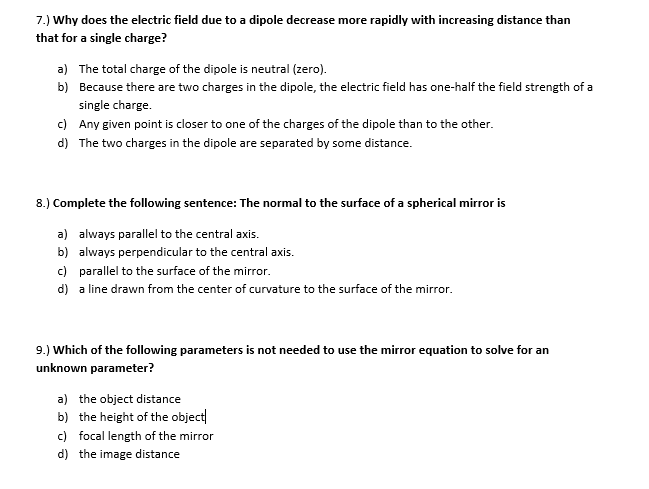7.) Why does the electric field due to a dipole decrease more rapidly with increasing distance than that for a single charge? a) The total charge of the dipole is neutral (zero). b) Because there are two charges in the dipole, the electric field has one-half the field strength of a single charge. c) Any given point is closer to one of the charges of the dipole than to the other. d) The two charges in the dipole are separated by some distance. 8.) Complete the following sentence: The normal to the surface of a spherical mirror is a) always parallel to the central axis. b) always perpendicular to the central axis. c) parallel to the surface of the mirror. d) a line drawn from the center of curvature to the surface of the mirror. 9.) Which of the following parameters is not needed to use the mirror equation to solve for an unknown parameter? a) the object distance b) the height of the object c) focal length of the mirror d) the image distance
7.) Why does the electric field due to a dipole decrease more rapidly with increasing distance than that for a single charge? a) The total charge of the dipole is neutral (zero). b) Because there are two charges in the dipole, the electric field has one-half the field strength of a single charge. c) Any given point is closer to one of the charges of the dipole than to the other. d) The two charges in the dipole are separated by some distance. 8.) Complete the following sentence: The normal to the surface of a spherical mirror is a) always parallel to the central axis. b) always perpendicular to the central axis. c) parallel to the surface of the mirror. d) a line drawn from the center of curvature to the surface of the mirror. 9.) Which of the following parameters is not needed to use the mirror equation to solve for an unknown parameter? a) the object distance b) the height of the object c) focal length of the mirror d) the image distance
College Physics
1st Edition
ISBN:9781938168000
Author:Paul Peter Urone, Roger Hinrichs
Publisher:Paul Peter Urone, Roger Hinrichs
Chapter16: Oscillatory Motion And Waves
Section: Chapter Questions
Problem 29PE: A pendulum with a period of 2.00000 s in one location (g=9.80m/s2) is moved to a new location where...
Related questions
Question
100%
6.) What is the distance between two successive antinodes of a standing wave?
a.) one-half wavelength
b.) one wavelength
c.) one-forth wavelength
d.) two wavelengths
please answer all thanks

Transcribed Image Text:7.) Why does the electric field due to a dipole decrease more rapidly with increasing distance than
that for a single charge?
a) The total charge of the dipole is neutral (zero).
b) Because there are two charges in the dipole, the electric field has one-half the field strength of a
single charge.
c) Any given point is closer to one of the charges of the dipole than to the other.
d) The two charges in the dipole are separated by some distance.
8.) Complete the following sentence: The normal to the surface of a spherical mirror is
a) always parallel to the central axis.
b) always perpendicular to the central axis.
c) parallel to the surface of the mirror.
d) a line drawn from the center of curvature to the surface of the mirror.
9.) Which of the following parameters is not needed to use the mirror equation to solve for an
unknown parameter?
a) the object distance
b) the height of the object
c) focal length of the mirror
d) the image distance

Transcribed Image Text:10.) Which one of the following quantities is not a factor in determining the natural frequency of a
string fixed at its two ends?
a) acceleration due to gravity
b) mass
c) tension
d) length
Expert Solution
This question has been solved!
Explore an expertly crafted, step-by-step solution for a thorough understanding of key concepts.
This is a popular solution!
Trending now
This is a popular solution!
Step by step
Solved in 2 steps with 1 images

Knowledge Booster
Learn more about
Need a deep-dive on the concept behind this application? Look no further. Learn more about this topic, physics and related others by exploring similar questions and additional content below.Recommended textbooks for you

College Physics
Physics
ISBN:
9781938168000
Author:
Paul Peter Urone, Roger Hinrichs
Publisher:
OpenStax College

Physics for Scientists and Engineers, Technology …
Physics
ISBN:
9781305116399
Author:
Raymond A. Serway, John W. Jewett
Publisher:
Cengage Learning

Glencoe Physics: Principles and Problems, Student…
Physics
ISBN:
9780078807213
Author:
Paul W. Zitzewitz
Publisher:
Glencoe/McGraw-Hill

College Physics
Physics
ISBN:
9781938168000
Author:
Paul Peter Urone, Roger Hinrichs
Publisher:
OpenStax College

Physics for Scientists and Engineers, Technology …
Physics
ISBN:
9781305116399
Author:
Raymond A. Serway, John W. Jewett
Publisher:
Cengage Learning

Glencoe Physics: Principles and Problems, Student…
Physics
ISBN:
9780078807213
Author:
Paul W. Zitzewitz
Publisher:
Glencoe/McGraw-Hill

An Introduction to Physical Science
Physics
ISBN:
9781305079137
Author:
James Shipman, Jerry D. Wilson, Charles A. Higgins, Omar Torres
Publisher:
Cengage Learning

College Physics
Physics
ISBN:
9781285737027
Author:
Raymond A. Serway, Chris Vuille
Publisher:
Cengage Learning

College Physics
Physics
ISBN:
9781305952300
Author:
Raymond A. Serway, Chris Vuille
Publisher:
Cengage Learning